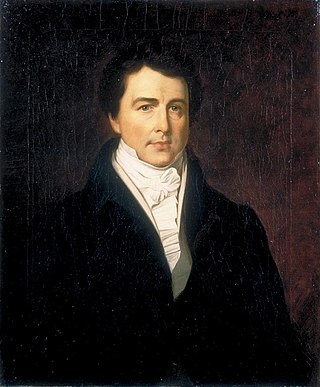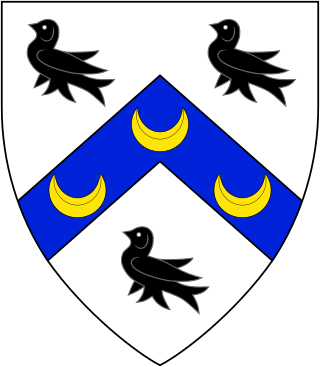
Baron Moncreiff, of Tulliebole in the County of Kinross, is a title in the Peerage of the United Kingdom. It was created on 9 January 1874 for the lawyer and Liberal politician Sir James Moncreiff, 1st Baronet. He had already been created a Baronet, of Kilduff in the County of Kinross, in the Baronetage of the United Kingdom on 23 May 1871. In 1883 Lord Moncreiff also succeeded his elder brother as 11th Baronet, of Moncreiff in the County of Perth. On his death the titles passed to his eldest son, the second Baron. He was a Judge of the Court of Session from 1888 to 1905 under the title of Lord Wellwood and served as Lord Lieutenant of Kinross-shire between 1901 and 1909. He was succeeded by his younger brother, the third Baron. He was a clergyman. As of 2010 the titles are held by the latter's great-grandson, the sixth Baron, who succeeded his father in 2002.

Baron Dufferin and Claneboye, of Ballyleidy and Killyleagh in County Down, Northern Ireland, is a title in the Peerage of Ireland. It was created on 30 July 1800 for Dame Dorcas Blackwood, widow of Sir John Blackwood, 2nd Baronet, Member of the Irish Parliament for Killyleagh and Bangor, in return for support for the Union of Ireland and the United Kingdom.
The Bishopp Baronetcy, of Parham in the County of Sussex, was a baronetcy in the Baronetage of England. From around 1780 the name was sometimes also spelled Bisshopp. It was created 24 July 1620 for Sir Thomas Bishopp who had previously represented Gatton in Parliament. He was by then almost 70 years old and who had earlier been created a knight by King James I on 7 May 1603 at Theobalds, shortly after James's accession to the throne. Thomas Bishopp was the son of Thomas Bishopp and Elizabeth Belknap, heir and daughter of Sir Edward Belknap, who was active in the service of the English crown, both on the battlefield and as a court official.

Sir Henry Chamberlain, 1st Baronet was a British diplomat, consul general to Portugal and chargé d'affaires to Brazil. He was created a baronet on 22 February 1828.

John Hamilton Dalrymple, 10th Earl of Stair, KT JP DL, styled Viscount Dalrymple from 1853 until 1864, was a Scottish peer and politician, who served as Governor of the Bank of Scotland for thirty-three years.
Sir Henry Gray Studholme, 1st Baronet CVO DL was a British Conservative Party politician who was the MP for Tavistock from 1942 to 1966.

Captain Sir Henry Chamberlain, 2nd Baronet was a British Army officer of the Royal Artillery and an artist whose series of drawings of Brazil were well known in his time.

There have been seven baronetcies created for persons with the surname Watson, one in the Baronetage of England, one in the Baronetage of Great Britain and five in the Baronetage of the United Kingdom. One creation is extant as of 2016.

The Farrington Baronetcy, of Blackheath in the County of Kent, is a title in the Baronetage of the United Kingdom. It was created on 2 December 1818 for General Sir Anthony Farrington, 1st Baronet.
Six baronetcies have been held by the Grant family.
There have been four baronetcies created for persons with the surname Hay, all in the Baronetage of Nova Scotia. Two creations are extinct, one dormant and one extant. A fifth baronetcy in the Jacobite Peerage, although theoretically extant, is not recognised by the Lyon Office.

The Dalrymple-Horn-Elphinstonebaronetcy, of Horn and of Logie Elphinstone in the County of Aberdeen, is a dormant title in the Baronetage of the United Kingdom. It was created on 16 January 1828 for Robert Dalrymple-Horn-Elphinstone. He was the grandson of Hew Elphinstone, second son of Hew Dalrymple, Lord North Berwick, third son of James Dalrymple, 1st Viscount of Stair. The second Baronet sat as Member of Parliament for Portsmouth. The fifth Baronet assumed the surname of Elphinstone-Dalrymple. The title became either extinct or dormant on the death of the seventh Baronet in 1956.
The High Sheriff of Queen's County was the British Crown's judicial representative in Queen's County, Ireland, Ireland from the 16th century until 1922, when the office was abolished in the new Free State and replaced by the office of Offaly County Sheriff. The sheriff had judicial, electoral, ceremonial and administrative functions and executed High Court Writs. In 1908, an Order in Council made the Lord-Lieutenant the Sovereign's prime representative in a county and reduced the High Sheriff's precedence. However, the sheriff retained his responsibilities for the preservation of law and order in the county. The usual procedure for appointing the sheriff from 1660 onwards was that three persons were nominated at the beginning of each year from the county and the Lord Lieutenant then appointed his choice as High Sheriff for the remainder of the year. Often the other nominees were appointed as under-sheriffs. Sometimes a sheriff did not fulfil his entire term through death or other event and another sheriff was then appointed for the remainder of the year. The dates given hereunder are the dates of appointment. All addresses are in Queen's County unless stated otherwise.
The High Sheriff of Wexford was the British Crown's judicial representative in County Wexford, Ireland from the 16th century until 1922, when the office was abolished in the new Irish Free State and replaced by the office of Wexford County Sheriff. The sheriff had judicial, electoral, ceremonial and administrative functions and executed High Court Writs. In 1908, an Order in Council made the Lord-Lieutenant the Sovereign's prime representative in a county and reduced the High Sheriff's precedence. However, the sheriff retained his responsibilities for the preservation of law and order in the county. The usual procedure for appointing the sheriff from 1660 onwards was that three persons were nominated at the beginning of each year from the county and the Lord Lieutenant then appointed his choice as High Sheriff for the remainder of the year. Often the other nominees were appointed as under-sheriffs. Sometimes a sheriff did not fulfil his entire term through death or other event and another sheriff was then appointed for the remainder of the year. The dates given hereunder are the dates of appointment. All addresses are in County Wexford unless stated otherwise.
The High Sheriff of Donegal was the British Crown's judicial representative in County Donegal in Ulster, Ireland, from the late 16th century until 1922, when the office was abolished in the new Irish Free State and replaced by the office of Donegal County Sheriff. The High Sheriff had judicial, electoral, ceremonial and administrative functions and executed High Court Writs. In 1908, an Order in Council made the Lord-Lieutenant the Sovereign's prime representative in a county and reduced the High Sheriff's precedence. However, the sheriff retained his responsibilities for the preservation of law and order in the county. The usual procedure for appointing the sheriff from 1660 onwards was that three persons were nominated at the beginning of each year from the county and the Lord Lieutenant then appointed his choice as High Sheriff for the remainder of the year. Often the other nominees were appointed as under-sheriffs. Sometimes a sheriff did not fulfil his entire term through death or other event and another sheriff was then appointed for the remainder of the year. The dates given hereunder are the dates of appointment. All addresses are in County Donegal unless stated otherwise.
The Sheriff of County Dublin was the Sovereign's judicial representative in County Dublin. Initially, an office for a lifetime, assigned by the Sovereign, the Sheriff became an annual appointment following the Provisions of Oxford in 1258. The first recorded Sheriff was Ralph Eure, appointed in that year. The next recorded Sheriff was Sir David de Offington, who was Sheriff in 1282. Besides his judicial importance, the sheriff had ceremonial and administrative functions and executed High Court Writs.
There have been two baronetcies created for persons with the surname Meredyth, both in the Baronetage of Ireland. Both are extinct.
There have been three baronetcies created for people with the surname Moncreiffe or Moncreiff, two in the Baronetage of Nova Scotia and one in the Baronetage of the United Kingdom. Two of the titles are dormant, as the heir has not proved his descent, and one is extant, though its holder does not bear the surname of Moncreiffe.

Sir James Montgomery, 2nd Baronet Stanhope, FRSE was a Scottish politician and lawyer who served as Lord Advocate of Scotland 1804 to 1806.
Sir Henry Hervey Aston Bruce, 1st Baronet was an Irish priest.








